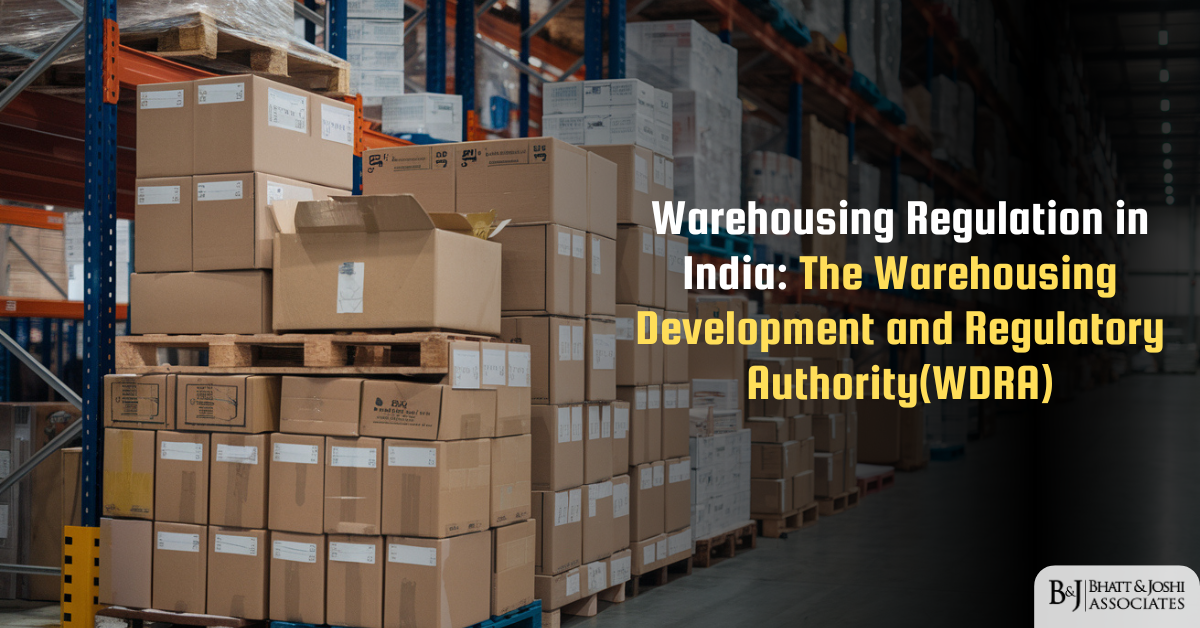
Introduction
The Warehousing Development and Regulatory Authority (WDRA) stands as a pivotal institution in India’s efforts to modernize and streamline its agricultural and commodities storage infrastructure. Established under the Warehousing (Development and Regulation) Act, 2007, WDRA aims to implement a nationwide warehousing receipt system, enhance the efficiency of warehousing operations, and promote scientific storage methodologies. This regulatory body plays a crucial role in bridging the gap between farmers, traders, and financial institutions, thereby contributing significantly to the overall development of India’s agricultural economy.
Historical Context
The concept of regulated warehousing in India can be traced back to the colonial era with the introduction of the Bombay Warehouses Act of 1879. However, the post-independence period saw a fragmented approach to warehousing regulation, with different states implementing varied policies. The need for a centralized regulatory authority became increasingly apparent in the late 20th and early 21st centuries, driven by factors such as:
- The liberalization of the Indian economy in the 1990s, which highlighted the need for efficient supply chain management.
- Persistent issues of post-harvest losses, estimated to be as high as 10-15% for some commodities.
- The need to enhance farmers’ access to credit and improve their bargaining power in the market.
These factors culminated in the formulation and passage of the Warehousing (Development and Regulation) Act, 2007, which laid the foundation for the establishment of WDRA.
The Warehousing (Development and Regulation) Act, 2007
The Warehousing (Development and Regulation) Act, 2007, is the cornerstone legislation that governs the functioning of WDRA. The Act came into force on October 25, 2010, marking a new era in India’s warehousing sector. The preamble of the Act clearly states its objectives:
“An Act to make provisions for the development and regulation of warehouses, negotiability of warehouse receipts, establishment of a Warehousing Development and Regulatory Authority and for matters connected therewith or incidental thereto.”
Key provisions of the Act include:
- Establishment of WDRA as the central regulatory authority for warehouses issuing negotiable warehouse receipts.
- Introduction of Negotiable Warehouse Receipts (NWRs) as a tradable document of title to goods.
- Registration and accreditation process for warehouses.
- Specification of the rights and liabilities of warehouse keepers and depositors.
Section 35(2) of the Act empowers WDRA to make regulations, stating:
“In particular, and without prejudice to the generality of the foregoing power, such regulations may provide for all or any of the following matters, namely:— (a) the form and manner of making application and the fee payable therefor; (b) the form of appeal to the Appellate Authority; (c) the procedure for registration of warehouses; (d) the financial, managerial and other eligibility criteria and competence which an applicant for registration of a warehouse shall satisfy…”
This comprehensive legislation has provided WDRA with the necessary legal backing to regulate and develop the warehousing sector in India.
Structure and Composition of Warehousing Development and Regulatory Authority (WDRA)
The WDRA is structured as an autonomous body under the Department of Food and Public Distribution, Ministry of Consumer Affairs, Food and Public Distribution, Government of India. The Authority consists of:
- A Chairperson
- Two full-time Members
- Not exceeding three part-time Members
Section 24 of the Act specifies the qualifications for appointment of Chairperson and other Members:
“The Chairperson and other Members of the Authority shall be persons of ability, integrity and standing who have shown capacity in dealing with problems relating to agricultural marketing, warehousing, insurance, finance, economics, commerce, logistics, law or administration or such other fields as may be deemed to be useful to the Authority.”
The Chairperson and Members are appointed for a term of five years or until they reach the age of sixty-five years, whichever is earlier. This structure ensures a blend of expertise and continuity in the Authority’s functioning.
Key Functions and Responsibilities of Warehousing Development and Regulatory Authority (WDRA)
WDRA’s mandate encompasses a wide range of functions aimed at developing and regulating the warehousing sector. Some of its key responsibilities include:
- Registration of warehouses for issuing Negotiable Warehouse Receipts (NWRs).
- Specifying the qualification and other requirements for warehousemen.
- Regulating the process of pledge, creation of charges, or other encumbrances on NWRs.
- Promoting efficiency in conduct of warehouse business.
- Promoting scientific warehousing of goods.
- Improving fiduciary trust of depositors and banks.
- Enhancing liquidity in rural areas.
Section 35(2)(zg) of the Act empowers WDRA to:
“Specify the duties and responsibilities of the warehouseman.”
This broad mandate allows WDRA to play a proactive role in shaping the future of India’s warehousing sector.
Negotiable Warehouse Receipts (NWRs)
One of the most significant innovations introduced by WDRA is the Negotiable Warehouse Receipt (NWR) system. NWRs are documents of title to goods stored in a registered warehouse. They serve multiple purposes:
- Proof of ownership of stored goods
- Collateral for obtaining loans from banks
- Tradable instruments in commodity markets
Section 2(m) of the Act defines a Negotiable Warehouse Receipt as:
“A warehouse receipt issued in accordance with the provisions of this Act expressing or endorsing therein, the right of the receipt holder to receive the goods specified in it and which is transferable by endorsement and delivery.”
The introduction of NWRs has significantly enhanced the liquidity of agricultural commodities and improved farmers’ access to credit. It has also contributed to the development of a more efficient and transparent agricultural marketing system.
Registration and Accreditation Process
WDRA has established a robust process for the registration and accreditation of warehouses. This process ensures that only warehouses meeting certain standards are allowed to issue NWRs. The registration process involves:
- Application submission with required documents
- Physical inspection of the warehouse
- Verification of financial and managerial capabilities
- Issuance of registration certificate upon satisfaction of all criteria
WDRA Regulations, 2017, in Regulation 4(2), specify:
“Every application for registration of warehouses shall be made to the Authority in Form-A along with a non-refundable registration fee as specified in Schedule-I.”
The accreditation process involves regular audits and inspections to ensure continued compliance with WDRA norms. This rigorous process has significantly improved the quality and reliability of warehousing services in India.
Regulatory Framework for Warehouses
WDRA has developed a comprehensive regulatory framework for warehouses, covering aspects such as:
- Infrastructure requirements
- Storage conditions and practices
- Security measures
- Record-keeping and documentation
- Staff qualifications and training
The WDRA (Warehouse Accreditation) Regulations, 2017, in Regulation 3, state:
“No person shall commence or carry on the warehousing business for issuing negotiable warehouse receipts unless he has obtained a certificate of registration from the Authority under these regulations.”
This regulatory framework has led to significant improvements in the quality and efficiency of warehousing services across India.
Warehousing Development and Regulatory Authority (WDRA) and Agricultural Marketing
WDRA plays a crucial role in improving agricultural marketing in India. By providing a standardized system of warehouse receipts, WDRA has:
- Enhanced price discovery mechanisms
- Reduced distress sales by farmers
- Improved market integration across different regions
- Facilitated the development of futures and derivatives markets for agricultural commodities
The introduction of NWRs has allowed farmers to store their produce during harvest time and sell when prices are more favorable. This has contributed to more stable agricultural incomes and reduced price volatility.
Electronic Negotiable Warehouse Receipts (eNWRs)
In a significant move towards digitization, WDRA introduced Electronic Negotiable Warehouse Receipts (eNWRs) in 2017. eNWRs offer several advantages over paper-based NWRs:
- Faster and more secure transactions
- Reduced risk of fraud
- Easier integration with electronic trading platforms
- Enhanced traceability of commodities
The WDRA (Electronic Negotiable Warehouse Receipts) Regulations, 2017, in Regulation 4(1), state:
“The Authority may, by order, declare that with effect from such date as may be specified therein, the issue of negotiable warehouse receipts shall be in electronic form.”
The introduction of eNWRs marks a significant step towards modernizing India’s agricultural marketing system.
Inspection and Enforcement
WDRA has established a robust inspection and enforcement mechanism to ensure compliance with its regulations. This includes:
- Regular inspections of registered warehouses
- Surprise checks to verify storage conditions and practices
- Audits of warehouse records and documentation
- Powers to suspend or cancel registration in case of non-compliance
Section 35(2)(s) of the Act empowers WDRA to:
“Specify the manner of inspection of warehouses.”
These enforcement powers have played a crucial role in maintaining the integrity of the NWR system and building trust among stakeholders.
Dispute Resolution Mechanism
WDRA has put in place a dedicated dispute resolution mechanism to address conflicts between various stakeholders in the warehousing ecosystem. This includes:
- A grievance redressal cell within WDRA
- Provision for appeals against WDRA decisions
- Mechanisms for arbitration in case of disputes between warehouse keepers and depositors
Section 42 of the Act provides for the establishment of an Appellate Authority, stating:
“The Central Government shall, by notification, establish one or more Appellate Authorities to be known as the Warehousing Development and Regulatory Authority Appellate Authority to exercise the jurisdiction, powers and authority conferred on such Appellate Authority by or under this Act.”
This multi-tiered dispute resolution mechanism has contributed to building confidence among stakeholders in the warehousing sector.
Impact on the Warehousing Sector
The establishment of WDRA has had a profound impact on India’s warehousing sector:
- Improved Quality Standards: WDRA’s registration and accreditation process has led to significant improvements in warehousing infrastructure and practices.
- Enhanced Financial Inclusion: The NWR system has improved farmers’ access to formal credit, reducing their dependence on informal moneylenders.
- Market Integration: Standardized warehouse receipts have facilitated easier trading of agricultural commodities across different regions.
- Reduced Post-harvest Losses: Improved storage practices have contributed to reducing post-harvest losses.
- Development of Commodity Markets: The NWR system has supported the growth of commodity futures and derivatives markets in India.
Challenges and Criticisms of Warehousing Development and Regulatory Authority (WDRA)
Despite its achievements, Warehousing Development and Regulatory Authority (WDRA) faces several challenges:
- Limited Coverage: As of 2021, only a small percentage of India’s warehouses are registered with WDRA, limiting the reach of the NWR system.
- Awareness Issues: Many farmers and small traders are still unaware of the benefits of NWRs.
- Infrastructure Gaps: Many existing warehouses, especially in rural areas, struggle to meet WDRA’s standards.
- Coordination with State Agencies: Given that agriculture is a state subject in India, WDRA sometimes faces challenges in coordinating with state-level agencies.
- Technological Adoption: The transition to eNWRs has been slow in some regions due to infrastructure and literacy constraints.
Warehousing Development and Regulatory Authority (WDRA) and Financial Inclusion
One of the most significant impacts of WDRA has been in the realm of financial inclusion. By providing a standardized, reliable system of warehouse receipts, WDRA has:
- Enabled farmers to use their stored produce as collateral for loans
- Reduced the risk for banks in lending against agricultural commodities
- Facilitated the development of innovative financial products for the agricultural sector
The Reserve Bank of India (RBI) has recognized NWRs as valid collateral for priority sector lending. In its Master Circular on Priority Sector Lending dated July 1, 2015, RBI states:
“Loans against Negotiable Warehouse Receipts (NWRs) with the benefit of priority sector classification would be available only up to 50% of the crop loan limit applicable to the cultivator.”
This recognition has significantly enhanced the financial value of NWRs and contributed to greater financial inclusion in rural areas.
International Comparisons
India’s WDRA can be compared to similar institutions in other countries:
- United States: The United States Warehouse Act provides for federal licensing of warehouse operators. However, unlike WDRA, it’s a voluntary program.
- Brazil: The Brazilian Warehouse Receipt System is similar to India’s NWR system but is more integrated with commodity exchanges.
- South Africa: The South African Grain Information Service (SAGIS) manages a system of silo certificates, which are similar to NWRs.
While WDRA draws inspiration from international practices, it is uniquely tailored to address the specific challenges of India’s agricultural and warehousing sectors.
Future Outlook
As Warehousing Development and Regulatory Authority (WDRA) moves into its second decade of operation, several areas for future development have been identified:
- Expanding Coverage: There’s a need to bring more warehouses under WDRA’s regulatory ambit, especially in rural areas.
- Technology Integration: Greater use of technologies like blockchain and IoT could enhance the efficiency and transparency of the NWR system.
- Capacity Building: Continued efforts are needed to build awareness and capacity among farmers, traders, and warehouse operators.
- Integration with E-NAM: Closer integration with the Electronic National Agriculture Market (e-NAM) could further improve agricultural marketing.
- Diversification: There’s potential to expand the NWR system to cover more commodities, including non-agricultural goods.
Conclusion
The Warehousing Development and Regulatory Authority (WDRA) represents a significant milestone in India’s efforts to modernize its agricultural marketing and storage infrastructure. By introducing a standardized system of Negotiable Warehouse Receipts, WDRA has contributed to enhancing transparency, efficiency, and financial inclusion in the agricultural sector.
While challenges remain in terms of coverage and awareness, the positive impact of WDRA on India’s warehousing sector is undeniable. It has improved storage practices, reduced post-harvest losses, enhanced farmers’ access to credit, and facilitated the development of more efficient commodity markets.
As India continues to strive for agricultural modernization and rural development, the role of WDRA becomes increasingly critical. The evolution of WDRA in response to emerging challenges and opportunities will be crucial in shaping the future of India’s agricultural economy.
The journey of WDRA thus far demonstrates India’s commitment to reforming and regulating its warehousing sector. As the Authority continues to evolve and strengthen, it holds the promise of fostering a more efficient, transparent, and inclusive agricultural marketing system in India.













